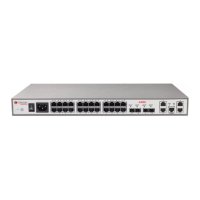A10E/A28E/A28F Configuration Guide
All devices in the whole switch network adopt the three time parameters on CIST root device,
so only the root device configuration is valid.
Configure timer for the A10E/A28E as below.
Enter global configuration mode.
Alpha-A28E(config)#spanning-tree
hello-time
value
Alpha-A28E(config)#spanning-tree
forward-delay
value
Alpha-A28E(config)#spanning-tree
max-age
value
7.5.13 Configuring edge interface
The edge interface indicates the interface neither direct connects to any devices nor indirect
connect to any device via network.
The edge port can change the interface status to forward quickly without any waiting time.
You had better set the Ethernet interface connected to user client as edge port to make it quick
to change to forward status.
The edge interface attribute depends on actual condition when it is in auto-detection mode;
the real port will change to false edge interface after receiving BPDU when it is in force-true
mode; when the interface is in force-false mode, whether it is true or false edge port in real
operation, it will maintain the force-false mode until the configuration is changed.
By default, all interfaces on the A10E/A28E are set in auto-detection attribute.
Configure the edge interface for the A10E/A28E as below.
Enter global configuration mode.
Alpha-A28E(config)#interface port
port-id
Enter physical layer interface
configuration mode.
Alpha-A28E(config-port)#spanning-
tree edged-port { auto | force-true
| force-false }
Configure RSTP edge port
attributes.
7.5.14 Configuring STP/MSTP mode switching
When STP is enabled, three spanning tree modes are supported as below:
STP compatible mode: the A10E/A28E does not implement fast switching from the
replacement interface to the root interface and fast forwarding by a specified interface;
instead it sends STP configuration BPDU and STP Topology Change Notification (TCN)
BPDU. After receiving MST BPDU, it discards unidentifiable part.

